Health Systems in Tabletop RPGs: Beyond Hit Points
Let's dive deep into something that's near and dear to every tabletop RPG player's heart: health systems. We all know the classic "hit points go down, character gets sadder" approach, but there's a whole universe of creative and engaging mechanics out there. Today, we're going to explore some interesting health systems from various games, dissect what makes them tick, and maybe even steal a few ideas for our own games or house rules.
Case Studies: Diving into Different Games
Let's take a look at some specific games and how they handle health:
Break: The Three-Heart System
Drawing inspiration from classic video games, Break employs a straightforward health mechanic: characters have three hearts, with each hit from a monster depleting one heart. Upon losing all hearts, characters begin to accrue injuries. The game features a variable injury table with escalating severity:
First Injury Roll: Primarily minor injuries.
Second Injury Roll: Introduction of more serious injuries, though minor ones remain possible.
Third Injury Roll: Increased likelihood of severe, potentially fatal injuries.
Reasoning: This system is elegant because it avoids complex math while still creating a sense of escalating danger.
Crown and Skull: The Death Spiral of Choice
Crown and Skull goes in a different direction, embracing a thematic "death spiral". Instead of tracking hit points, damage is applied directly to your character's skills or equipment.
Whenever you take damage, you get to choose which skill or piece of equipment suffers. This is huge for player agency! You can narratively justify why you're losing your ability to stealth or why your sword broke. The loss of skills and equipment forces you to adapt your tactics on the fly. No more sneaking? Time to go in swinging! Weapon broken? Time to get creative!
Reasoning: Crown and Skull prioritizes thematic storytelling and player choice over mathematical precision. The death spiral mechanic creates a sense of mounting pressure and encourages players to think outside the box.
Mothership: Stress, Panic, and the Void
Mothership is a sci-fi horror RPG, and its health system reflects that. It combines traditional hit points with stress and panic mechanics to create a sense of psychological dread.
Stress accumulates as characters encounter terrifying events or take damage. At random intervals, players must make a panic check by rolling 2d10 (in 1e its 1d20). If the result is less than their current stress level, they roll on the panic chart.
The panic chart is a table of escalating consequences, ranging from minor adrenaline rushes to crippling fear and even death. The higher your stress, the worse the potential outcome, because you ADD your stress to your 2d10 (1d20) roll!
As you level up, you gain resolve which allows you to subtract from the panic die when you have to add stress. Because getting Lower results is actually a BOON. Getting a 1-7 will result in bonuses to your actions.
Reasoning: Mothership's system is brilliant because it creates a constant sense of tension and uncertainty. You never know when the next panic check is coming, and the higher your stress, the more terrifying the possibilities.
Chart Thoughts
Both Mothership and Break!! implore the use of charts. There are pro’s and con’s to charts, that you can consider in your game.
Benefit of a chart:
Knowing the possible threats There is power in a chart showing all the possibilities. By seeing what you might roll, or what you could roll…that builds tension!
Help with Creativity: Sometimes charts just give a hint of an idea. That then sparks the player and the GM the opportunity to expand on it and fit it into the narrative. (the counter argument to this is Theme below).
Drawbacks of a chart:
Referencing frequently: If the chart isn’t on the character sheet or on the table then you have to constantly flip to it, or look it up. Could slow down play time and the suspense of the situation.
Theme: Sometimes charts can be bland, or generic in nature. When the GM makes up consequences they can be highly relevant to the situation. Charts sometimes feel disconnected.
Cosmere RPG: Long-term Injuries
This system combines standard hit points with an injury table, which is rolled on whenever a character's HP drops to zero. Injuries are classified as minor, major, or severe. Once the severity is determined, a second roll determines the specific effects of the injury, which can last anywhere from 1d6 to 6d6 days—or even be permanent. Injuries also increase vulnerability to future harm; each time a character reaches 0 HP, they roll a d20 to determine their new injury, but if they already have injuries, they take a -5 penalty to the roll for each one. If the total result ever reaches -6 or lower, the character dies.
Reasoning: This system creates a sense of escalating danger and long-term consequences. The growing penalty for repeated injuries reinforces the idea that reckless combat has lasting effects, forcing you to consider recovery or avoiding unnecessary fights.
Broken Empires: Location, Location, Location
The health and damage system in Broken Empires is designed as a "simulation light" approach, focusing on streamlined mechanics while still maintaining tactical depth. Damage is applied to specific body parts, adding a layer of realism without excessive complexity.
Players make skill checks by rolling a d100 (2d10 that represent tens and singles), aiming to roll as high as possible without exceeding their skill percentage, much like blackjack. The enemy also rolls a d100 (2d10) for defense, and the difference between the rolls determines success.
For every ten points by which the player's roll exceeds the enemy's roll, they gain one SP point, which can be spent on actions or damage. The singles digit of the player's roll determines which body part is hit, while the difference in the tens digit between attacker and defender dictates damage severity.
If damage surpasses a threshold for a body part, it results in a wound, and from what I understand they are abstracted wounds. While injuries such as leg wounds may slow a character, they do not drastically alter gameplay, keeping the system straightforward while allowing for some tactical decision-making.
Hardsuit: Mech Mayhem and Strategic Sacrifice
Hardsuit, a game where you play as pilots in mechs, offers an interesting take on health. Your mech has a certain number of hits it can take per limb (arm, leg, chest, etc.).
Different powers and abilities are tied to specific limbs. If a limb takes too much damage, those abilities become unusable. You as a player assign damage to the area of your choice. This allows for a LOT of player agency and decision making.
Reasoning: This system encourages strategic allocation of damage. Do you sacrifice an arm to protect your chest? There is a threat of losing abilities, but does that just provide a breaking of typical strategies? Or do players just always lose the same limb?
Daggerheart: Damage Thresholds
Daggerheart employs a unique health system that integrates both hit points and stress, deviating from traditional damage mechanics by utilizing damage thresholds instead of simple subtraction from hit points. When a character is hit, they receive a variable amount of damage—either one, two, or three points—determined by the attack roll in relation to their individual damage thresholds.
Each character has two personal threshold values (e.g., 8 and 16), which dictate how much damage they take from an attack. If the damage roll is below the first threshold (e.g., 7 or less when the threshold is 8), the character takes only one damage. If the roll falls between the two thresholds (e.g., 8 to 15 with thresholds of 8 and 16), they take two damage. If the roll exceeds the second threshold (e.g., 16 or higher), they suffer three damage.
This system significantly impacts how different characters feel and perform in combat. Those with higher thresholds take less damage overall, reinforcing a sense of resilience, while characters with lower thresholds remain more vulnerable. Additionally, the way damage is handled also depends on mitigation factors, such as armor, which further influences survivability and tactical decision-making.
Reasoning: These thresholds change how characters feel, as some might consistently take less severe damage while others are more susceptible to major hits. It also reduces the variability of damage. The game knows you will take 1-3, and not 1-30 on an attack, so it’s less swingy. Monsters can still do large damage amounts, it just means they will more often do 3 damage to a character.
Daggerheart also includes a stress mechanic, though it’s not the primary focus here. Essentially, if a character would gain stress but their stress track is full, they instead mark a hit point. Stress can be spent on certain abilities, and the GM has the ability to apply stress as well.
Tales from Elsewhere: Targeted Injuries and Escalating Damage
This is a damage system that emphasizes escalating injuries and targeted body hits. Instead of a simple hit point system, it categorizes injuries into different degrees, including; strain, serious, critical, and lethal damage.
Damage is determined by rolling a damage die, with different weapons using different dice. The goal is to roll low, the lower the roll, the more severe the damage. Because of this, deadly weapons use smaller dice. For example, a fist might use a d20, while a gun could use a d8.
4+ = strain
2-3 = serious injury
1 = critical injury
Lethal damage isn’t directly rolled—it only occurs under specific conditions, such as targeting the head.
Players can choose to aim at specific parts of the body: the bulk (chest), the brim (arms and legs), or the ace (head). Targeting limbs might disable movement or actions, while hitting the head increases the severity of injuries. If a character rolls a one while striking the ace, for example, the severe damage instead becomes lethal.
If the character takes more damage of the same type, but has no slots for that type, it escalates to the next level. If all strain boxes are full and the character suffers another strain result, it upgrades to serious injury. Additionally, wounds are thematic—players describe their injuries, which can carry complications based on weapon tags such as "disabled" or "agonizing," adding depth to the storytelling and mechanical impact of damage.
Reasoning: This system shares conceptual similarities with FATE in its use of strain (akin to stress) and escalating consequences, but implements them in a more structured way. By incorporating called shots, and weapon dice types, it adds an element of strategic choice. The way damage escalates when no available slots remain creates a sense of mounting tension, reinforcing the game's narrative-driven approach to injuries and survival.
FATE: Stress and Consequences.
In this system, players have stress bubbles. If all of a character’s stress bubbles are filled, they are knocked out, representing their inability to continue effectively in the scene.
Instead of simply taking stress, players have the option to convert it into minor, major, severe, or extreme consequences. The amount of stress that can be exchanged for a consequence depends on the severity of the consequence.
Consequences are more lasting than stress and have thematic effects that influence gameplay. In FATE, consequences function similarly to aspects, which the Game Master (GM) can invoke using fate points. For instance, if a character suffers a sprained ankle as a consequence, the GM could spend a fate point to invoke that aspect, granting an advantage to an enemy’s attack or creating a situational disadvantage for the character.
The ability to take consequences instead of stress represents an example of player agency, allowing players to make meaningful choices about how their character handles adversity and shaping the narrative through their injuries and setbacks.
Memento Mori: Taint and Power
Memento Mori features a unique corruption mechanic, where pushing oneself too far results in accumulating damage or stress, represented as "corruption." This mechanic reflects the idea that power comes at a cost, as characters increase their corruption they increase their strength and unlock new abilities. However, this power comes with significant risk.
As corruption accumulates, characters become more susceptible to further corruption, creating a death spiral. The more corruption a character has, the easier it is to gain even more, bringing them closer to their inevitable demise.
By tying power progression to self-inflicted deterioration, Memento Mori establishes a deliberate trade-off between strength and life.
Reasoning: The game creates a deliberate death spiral where players trade health for power, offering a trade-off.
The Heart of the Matter: What Makes a Good Health System?
Meaningful Choices: A good health system should force players to make tough decisions that impact their character's abilities and playstyle. Player Agency.
Thematic Resonance: The consequences of taking damage should feel appropriate for the setting and genre of the game.
Tactical Implications: Damage should alter the way players approach combat and other challenges, encouraging them to think strategically.
Tension and Excitement: A well-designed system can create a sense of danger and urgency, making each encounter feel more impactful.
Streamlined Mechanics: Nobody wants to spend half their turn flipping through rulebooks or doing complex calculations. The system should be easy to learn and use.
There are probably a laundry list of other cool games that I don’t have on this list..would love to hear about them in the comments!
Key Elements for an Effective Health System
So, what can we learn from all these different games? Here are some key elements that contribute to a compelling health system:
Thresholds and Injury Stages: Implement a threshold that must be surpassed before injuries or conditions are applied (HPs or Stress?). Subsequent injuries should increase in severity, influencing how players approach the game.
Variable Triggers and Stress Meters: Incorporate a side track, such as a stress and panic system, with a building meter and unpredictable triggers for rolls. As it builds rolls are worse! This creates tension and anxiety as players anticipate potential consequences from rolls that may or may not come.
Player Agency: Provide players with choices in how they manage damage or apply consequences. This can involve choosing which skills or equipment to sacrifice or strategically allocating damage to different body parts.
Thematic Consequences: Ensure that injuries or conditions have thematic effects that impact gameplay. This can involve mechanical impairments, narrative complications, or changes in character behavior.
Streamlined Mechanics: Design the system to be intuitive and easy to use, avoiding excessive complexity or reliance on hard to use tables buried in books. Integrate essential information, such as injury tables, directly into the character sheet for quick reference.
Meaningful Choices: The health system should encourage players to change their tactics based on the situation, rather than simply hoping for lucky rolls.
Final Thoughts
Health systems are more than just a way to track damage. They're a cool element of game design that can influence player behavior, create tension, and enhance the overall gaming experience. By studying different approaches and incorporating the key elements we've discussed, we can create health systems that are both engaging and FUN!



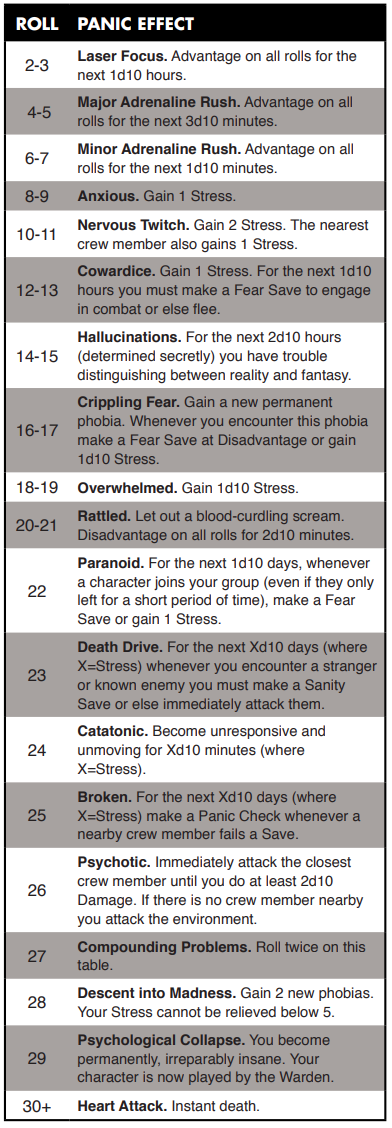

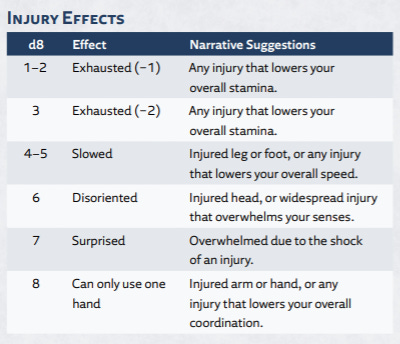

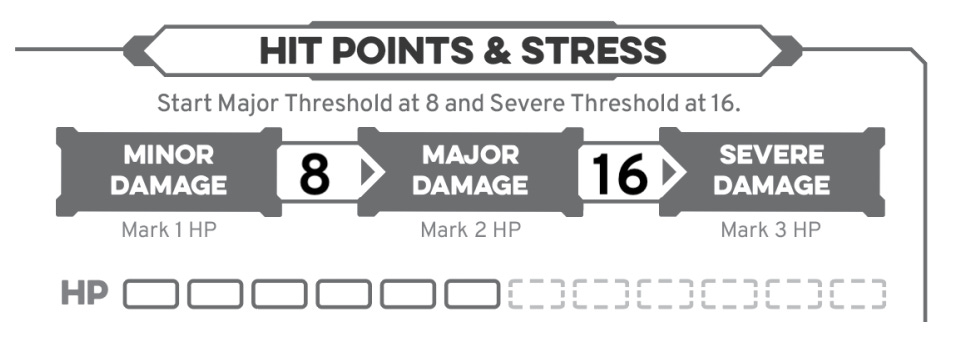
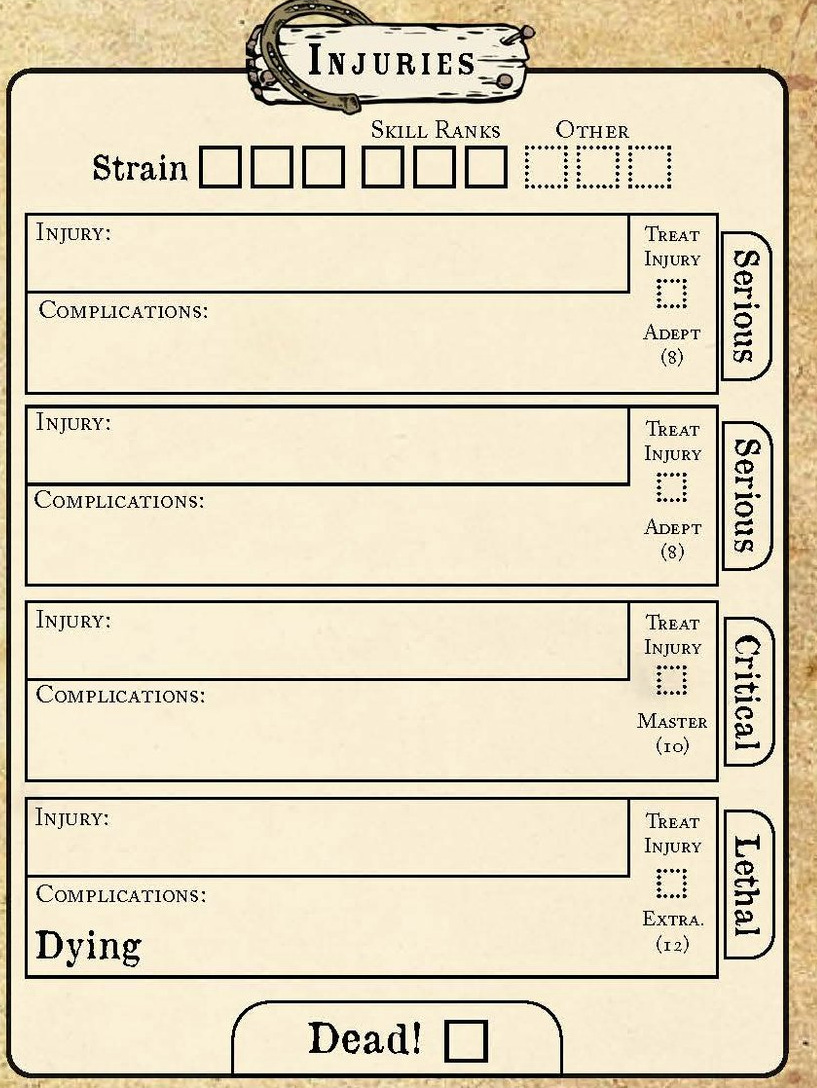

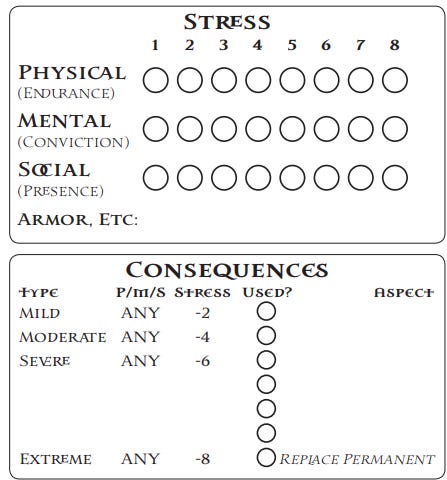
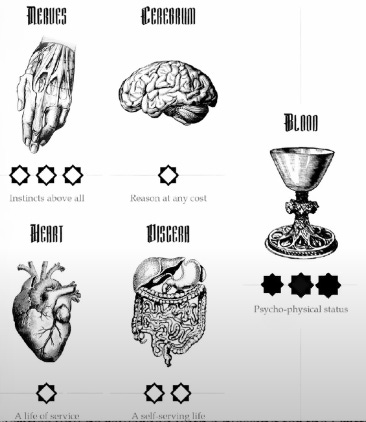
The first corruption system I ever saw was in Aberrant. As a super powered being you could voluntarily and involuntarily take a point of taint. You would get more powerful or survive a death blow, but you could never reduce it. Once you got 10 points your character was lost and became an NPC. It was separate from the HP system but connected in a couple of ways. It was an interesting system to play.
Hey Eric,
That's a great question. I might have to follow-up and do just that! I wrote a newsletter awhile back looking at creating a Module game, and then thinking about which modules to add to your game based on your Theme/Genre that you were trying to invoke
https://jfacegames.substack.com/p/exploring-a-full-module-game-design
Let me know if this scratches some of that itch in terms of designing a health system for such a game!